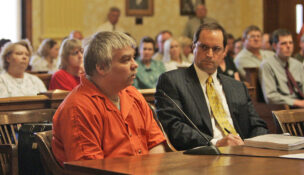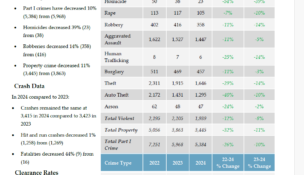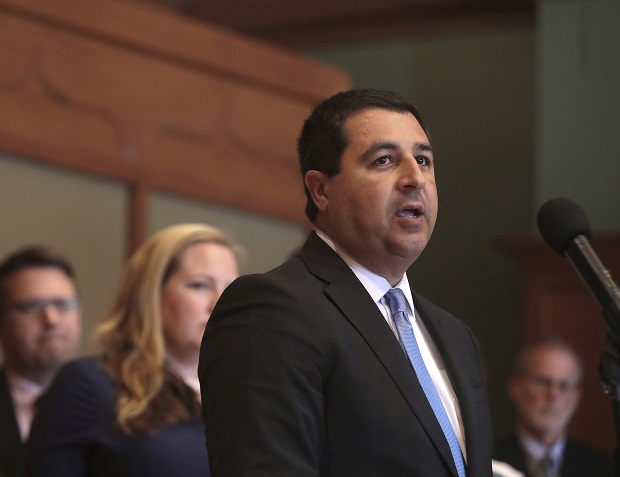Roundtable Discussion
By: dmc-admin//August 11, 2004//
Crisis Management
 |
|
Evan N. Zeppos, Zeppos & Associates; Jeffrey P. Clark, Reinhart Boerner Van Deuren, s.c.; Charles B. Palmer, Michael Best & Friedrich, LLP; Nathan A. Fishbach, Whyte Hirschboeck Dudek, S.C.; and David B. Kern, Quarles & Brady, LLP. |
WISCONSIN LAW JOURNAL: There was some discussion earlier about consolidating where communication is coming from, making sure that there’s a central point of communication. What elements go into determining who that point of communication is going to be?
EVAN N. ZEPPOS: Well, there are differences. Is it someone who’s going to field the calls if they’re coming in from different stakeholders? Or is it someone who’s going to be the spokesperson, who’s going to respond [to the media].
They’re really two different functions to me, and I think they should be. I don’t want to put my media spokesperson immediately in front of the media without some sense of where they’re coming from, what are the issues, what are the challenges, what are the topics, what are the remaining questions? Just hearing those questions before you go out there, even if it’s five minutes, allows someone like myself and Nathan to turn to the client and say, “Now, where do we go with this issue?”
JEFFREY P. CLARK: Have basic talking points prepared with a team approach before you’re in the media spotlight.
ZEPPOS: I raise a red flag for the group to consider though. It’s coming out more and more in both the academic journals that I read and the trade magazines that I follow. I’m a big proponent of get your message out and get your talking points up. But reporters are getting smarter. They’ll ask that first question, and the spokesperson will give those required three or four talking points. And the reporter will basically say, “OK, you got your talking points out; now I’m going to ask you again…” You have to be ready to go a little bit below the surface.
I’m not saying be expansive, disclose all the information. … But you have to be ready to kind of deal with the situation.
CLARK: Someone who’s versatile, but perhaps not your CEO.
ZEPPOS: If the situation is that a company is alleged to have improperly disposed of materials through its solid waste contract and they’re hot and they should have gone out a different way, I don’t think that’s the type of thing where I believe that a CEO should be out in front.
You may want someone who’s the director of compliance. It may be a VP of corporate communications or director of communications. If there’s a fatality in the facility or something that strikes to the very integrity of the company, it’s more than likely that someone in my role is going to suggest that this is a place where the CEO is going to step up.
I’ll show you where the heads butt. Because lawyers are going to say, “He’s probably going to have to testify in this case.” And I’ll say, “Yeah, it’s possible that he may. But right now the integrity of this company is on the line.”
I’m not trying to say don’t worry about the court case six months down the road. But I’ve got 35 minutes before the newscast goes on. And they want something from the company on a death in the workplace. How do you want to handle this one? That’s the challenge. That’s where the rubber truly meets the road in these situations.
|
Jeffrey P. Clark
Clark actively participates in professional organizations that work to prevent and manage community emergencies and disasters. Clark represents manufacturers, employers, healthcare organizations, real estate developers, contractors, and individuals. He has represented clients before the Department of Natural Resources, the U.S. Environmental Protection Agency, the Occupational Safety and Health Administration (OSHA), state courts in Wisconsin and Colorado, and federal trial and appellate courts nationwide. Clark received his law degree from the University of Wisconsin in 1979. Nathan A. Fishbach
He co-authored with Professor Jay Grenig "Wisconsin Practice: Civil Procedure Forms," a three-volume book, for Thompson-West. They are currently updating "Wisconsin Practice: Methods of Practice." David B. Kern
Kern has written and spoken on a variety of employment-related issues. Among other things, he co-authored, "Wisconsin Employment Law," for the State Bar in 1994, and worked on supplements and subsequent editions from 1995 to the present. Kern is a 1979 graduate of the University of Michigan School of Law. Charles B. Palmer
Palmer has handled many OSHA citation cases, including fatality cases. And he has led labor negotiations for high profile employers and has led clients through union corporate campaigns. Palmer received his law degree from Marquette University Law School in 1990. Evan N. Zeppos
Previous and current assignments include providing issues management, public relations and government affairs assistance to Wisconsin’s largest telecommunications and gas companies; a major brewer; several large, privately owned, Wisconsin-based international companies; the world’s largest convenience store operator and various other private and public business organizations. His crisis management experience has brought him assignments that range from product recalls and train derailments to workplace deaths, legal actions and construction accidents. |
CHARLES B. PALMER: I kind of view the PR person in this capacity as sort of the lawyer’s counselor. And you have to balance your legal issues with what’s in the best interest of the company from a PR standpoint. Lawyers act as a good brake. And I kind of view the PR person as the gas, saying “We’ve got to get out there, and we’ve got to get the message out there.”
In these kinds of situations, it’s stressful for the lawyer as well. I’ve got to try to get communication. I also have to figure out all the issues that the company’s going to have to deal with immediately.
I’ve been convinced in cases that it’s the CEO who has to be out there. My typical response is, “I don’t want to put that person out there on the line.” They’re stressed out as it is. But at the end of the day, it’s a communication that’s not only going out to the public but, as was said earlier in this process, your employees are watching the news. … That’s who people are really looking to within the organization. Does the company owner, or the top person, really get involved and care about this company? Or does he run and hide when there’s a stressful situation?
You really have to look at whether the issue is so severe that if he gets up there, there is the potential for criminal issues that could deprive that person of freedom for the rest of his life. Then I’m going to look at an issue and say, “We’ll just have to take our lumps on the PR end of things.”
If I hear the PR person telling me that I’ve got to have the CEO out there because … this is going to be a significant concern for the company, I’m going to balance that in terms of the legal issues.
DAVID B. KERN: On the question of the ideal spokesperson, obviously that’s going to vary from situation to situation. But I’d be looking for two primary traits.
The first is someone who can be calm under fire. Because I think that nervousness is infectious. I’m reminded of the Saturday Night Live skit when Martin Short would be the corporate spokesperson with the sweat coming out of his forehead. Someone who’s calm and can portray confidence under fire does wonders to calm waters and restore confidence.
The other thing is intelligence. It’s a little like basketball, where you can’t coach height. You can’t prepare someone for the second, third, or fourth-level question from a reporter unless that person’s got enough intelligence to understand where the pitfall is and isn’t going to step into it when that person has to expand a little bit.
ZEPPOS: The group has been talking about planning and things like that. I’ll just augment a little bit. What you also want to do is you want to have that person trained in advance. I’m not saying they have to go through a boot camp type of thing… But someone has to sit down, well in advance of any potential crisis, and go through a media training program so they understand the way the media does its job and how they handle it in a crisis.
I’ve seen it because Martin Short does live out there … and it could be a CEO and it could be someone else. You have the one end of the spectrum where someone says, “We’re not making any comment.” You know that you have to turn this guy around. Someone has to say something, even if it’s a written statement.
Then there’s a person
who says, “Don’t worry, I can handle the media.” And when you see that you go, “Uhh… Well, this one is going to be just a little different.” … Then you sit there and you watch them just melt under the camera.
NATHAN A. FISHBACH: It’s interesting that there seems to be a consensus among us about the inherent tension and stress in a crisis situation. When we were in law school, people would talk about the stress of the trial. And trials are stressful, but think about it. It’s a very controlled setting regulated by a judge. Generally at trial, there are very few surprises. It’s almost scripted.
By contrast, the situation where something surprising happens, a crisis to a company, is totally different because it’s not scripted. You don’t know what the next step is going to be, and you don’t know what anyone is going to say. So it’s a very tough situation where you’re trying to disclose to your stakeholders your position … and make sure that you give confidence to your stakeholders, but also protect against the possible liability of your company.
CLARK: We, for good reasons, have been focusing on the public relations aspect and what someone like Evan brings to the table. But as Chuck would know, in the OSHA setting we may end up dealing with safety consultants who are not employed by our client. We bring them in from the outside — engineers, industrial hygienists. We need to work with a variety of experts and consultants in formulating the response to the crisis. So some of the issues we’ve talked about are broader than just the media aspect, as critical as that is.
WLJ: I want to take a step back and look at talking to your clients before a crisis situation arises. I believe Jeff talked about the importance of doing a risk assessment. When you’ve got a corporate client or a municipality that is looking at dollars and cents and saying, “How much am I spending on my legal expenses?”
How do you impress upon them the need to spend the money to do a full-blown risk assessment?
CLARK: Well, there are different levels of risk assessments. Making the case to management to expend resources on this is a challenge. I’m not sure there’s any set answer to that. But there are four basic steps that you want to look at. Actually, FEMA has published this on their Web site.
You want to establish a planning team. I think we talked about that and who should be on the team. That team wants to have some authority, meaning management has to buy into the process. You need to have sort of a mission.
Second, what capabilities does the business have and what hazards does it face? There, you conduct the vulnerability assessment for a risk assessment. Here’s an example from the cyber world. If our computer system is taken down by hackers or a virus, obviously our ability to service our clients’ needs is going to be jeopardized tremendously. That’s probably true across the business community at large today because of our reliance on technology.
So we may want to not only internally look at how we might be penetrated and how someone can cause havoc inside our computer system, but have an outside expert in a very confidential manner, probe us for weaknesses, find our vulnerabilities, and confidentially report that to us. Then we see how we can address those vulnerabilities and solve those problems… This is not different than what businesses normally do in their planning process. It’s just bringing a lot of the same tools to bear on this area.
Once you know where you’re at risk and what hazards you face, you develop a plan to address it. You try to get resources, bring training to bear, coordinate with outside experts. Then I think you want to conduct some drills. You can have a table-top discussion where you literally get around the table and you create a scenario of a crisis, disaster, or emergency. Then you respond to it.
Finally, you want to implement the plan. You want to establish some measurements of your progress and you want to reevaluate that on an ongoing basis. That whole approach cannot really be alien to management’s normal thinking, because that’s how they run their businesses.
Selling crisis to management can be challenging. … You can tell them, “We want to avoid fatalities. We want to protect the safety of our employees and our stakeholders. Beyond the OSHA citation, it creates worker’s compensation costs. It lowers the productivity of our employees. It hurts morale.”
Those are the types of things that you need to look for in making the case to management that this is worth doing. But it’s not always easy.
KERN: You’ve put your finger on the point of trying to make real the risks that an employer faces. An employer in collective bargaining negotiations ought to be thinking about strike planning. That’s not even crisis planning because that’s not a crisis. That is a possible outcome, and you’d better be prepared for it. Trying to convince an employer that he needs to think about what happens if a plane flies into its building and where is it going to set up shop tomorrow is a tougher sell. It’s probably not very likely, and you’re not going to get an employer or a client to listen very carefully to that.
So using people who are experienced, reading the literature, getting a sense of the risks that an employer is likely to face, or a client is likely to face will help, but this is a challenge. I don’t think there’s an easy answer to it.
FISHBACH: One of the things Jeff was talking about, doing a risk assessment, is very similar to a compliance plan. Companies should have compliance plans to be good corporate citizens. It’s also good preventative medicine so that, if something happens, you’re in a place to show your good faith in trying to be a good corporate citizen and complying with the laws.
The downside to all of this is, if you develop a compliance plan or a vulnerability plan and don’t follow through on it, you’re creating additional problems for your company. Once you develop the plan, you have to follow through on it. If you have a compliance plan which says that you have a certain hazard in your company, and you don’t fix it, that will be the Exhibit No. 1 in the government’s case against you. So the key in having any type of plan is
following through.
CLARK: Right. For example, in the OSHA setting, that type of approach would help you show good faith to the regulator. The flip side is, if your safety committee is saying here’s what we need to do to address these hazards and management routinely turns a blind eye to that, the prosecutor or the regulator will focus on that.
PALMER: As a lawyer, you have opportunities to convince your client that some preplanning may make sense. Every day, lawyers are talking with their clients about a specific case that they’ve got. Many of those cases may not be a disaster or a crisis. But they sure could have been.
So I think you should use your opportunities as a lawyer properly. When you’re handling a particular case, say, “Let’s look at how this particular situation was handled. What if this had been much more serious? How would we have responded to this particular event?”
Use the opportunity of the case that you’re dealing with right now to convince the client that a better plan for dealing with these types of things might be in order…
Perhaps, you just start small and deal with one aspect of the crisis management. Then you work your way to the bigger plan. So that develops the client’s interest in the particular issue. You could agree to do a one-hour presentation at the annual employee training on dealing with crisis situations. Part of your outline is the company should have a crisis management plan.
CLARK: I talked before about the need for collaboration and cooperation. And the partnership is developing between the public sector and the private sector, and that’s important. For example, the FBI had a program called the National Infrastructure Protection Program. It’s designed to work with private industry and government agencies to safeguard their computer networks from hacker attacks and so forth. That has really evolved into a program that is also being handled in the Department of Homeland Security at the federal level.
Each FBI field office, including our office here in Milwaukee, is a stakeholder in this. … They will work with private companies as well as governmental organizations to safeguard their computer systems and share information between the public and the private sector in best practices to protect computer networks.
That’s just an example of where there will be increasing synergy and collaboration, partnership between government and the private sector and then within each of those spheres.
We’ve talked about why we need to have a team and we need to have different perspectives and viewpoints. And that’s a way that a business can really participate in some efforts like that and draw benefit from other people … so you’re not reinventing the wheel on your own.
FISHBACH: Trying to sensitize the corporations to these issues, I recommend sometimes that they read some of the literature that’s been written relatively recently regarding crisis. A book that I thought was very helpful was a book about Cantor Fitzgerald, which was the firm in New York which was literally decimated by 9-11, and how they responded to getting the company moving again, but also some of the public relations coverage from some of the benefits they were providing to the victims. [“On Top of the World: Cantor Fitzgerald, Howard Lutnick, and 9/11: A Story of Loss and Renewal” by Tom Barbash.]
The other literature would be relating to the Andersen-Enron scandal. There is a recent book by some Wall Street Journal reporters talking about how they investigated the Enron matter. [“24 Days: How Two Wall Street Journal Reporters Uncovered the Lies that Destroyed Faith in Corporate America” by Rebecca Smith and John R. Emshwiller.] It gives insight into how reporters view a company’s crisis and how they try to obtain additional information.
CLARK: Companies have a lot of data that they can utilize in conducting this type of analysis. … In the OSHA setting, you look at your injury logs, your OSHA 200 and 300 logs. You look at your worker’s compensation reports. You find out how employees are being hurt and, very importantly, the near misses, how they come close to being hurt. Then you work with your own employees and outside resources as needed to come up with a plan to determine what the top three causes of injury or near injury to employees are. You take action steps to eliminate those causes.
Similarly, you pull your stakeholders together across your organization and you ask, “What risks and hazards confront us as we conduct business.” Then you try to be systematic about coming up with a plan to address those hazards and risks. You think about it in advance of the crisis happening, for all the reasons we’ve been talking about.
WLJ: We’re almost out of time, but I’d like to go around the table and see if there are some final thoughts that you have about helping clients with crisis management.
PALMER: Every lawyer who is dealing with a business should think about the types of work that they’re doing for that business, what are the issues for the particular business that they deal with and, what is the worst-case scenario or the close-to-worst-case scenario that they might have to deal with in the future? Start to think about developing a crisis management plan for the client around that particular issue.
Other issues will then develop off of that. But we should at least learn from our experiences with a particular client to help with prevention for the future. The litigation is one aspect of our business, but I think prevention will help our clients stay in business.
Those primary issues have to be looked at not as individual incidents, but to see if there are patterns, there are things which could be the train wreck in the future.
Start to get creative about how you are going to prevent the catastrophe for the client… You want to surround yourself with professionals who you trust, who can do a good job for your client, and who you can work with in a situation that’s very stressful.
KERN: I would echo much of what Chuck said. I think there is absolutely no substitute for thorough planning, as I mentioned earlier. If you take a very likely scenario like a strike in
a negotiation situation, it’s easy to think about the possibilities. It’s easy to plan for them. You can convey the calmness that comes with being in control and being able to help your client through something like that.
As the risk gets more remote, it’s obviously tougher to convince the client that it’s important to think about it. But whether it’s avoiding hackers in your IT system or whatever it might be, there’s absolutely no substitute for planning. Lawyers are good planners. … We think in an organized way about how to approach a problem.
The other thing that I would stress is that we ought not to be limited by our training. When we are asked about a legal issue, we tend to give an opinion on the legal issue and then we are done. It’s important, particularly when you know a business well, to be proactive and be creative.
We are partners with our clients. If we see an issue or are aware of a problem, I think it behooves us to raise that issue with the client. Then, it will be up to them as to whether they act or not. That’s a true counselor role.
ZEPPOS: I believe that the proper job for the public relations person is to support the legal team and to provide support in litigation. We don’t argue in court. We don’t meet with the DA. We don’t meet with OSHA. I try to stay out of depositions at all costs. But it doesn’t mean that we would blindly follow legal advice of the lawyer. There has to be a balance that preserves the legal position and the legal strategy, but also recognizes that the court of public opinion is very, very different.
We have to find a way of working together to reach that proper balance.
In some ways — and I don’t want this to sound cavalier in this group or to come across in print as cavalier — it won’t matter what happens in court in 13 months if in the first 60 days you’re convicted in the court of public opinion. The advice that I give people is that you have to react fast, you have to be honest and it’s usually best to be first.
Going into a “no comment,” ostrich approach is just a prescription for guaranteed disaster. Responding to the media or even proactively communicating with the media is probably going to get you ahead of the curve. The concept of being open is going to make a great deal of difference as you go forward.
FISHBACH: I think the consensus is that planning is essential. The best time to see a cardiologist is before you have a heart attack. It’s inevitable that a company or a municipality will face a crisis. The question is when and in what form. The true challenge is how they react to it. If they act appropriately, they will become stronger to meet the other challenges.
| |
||
|
Related Article |
||
| |
||
CLARK: I think communication, cooperation, and collaboration are critical to prepare for crises. Trying to avoid crises in the first instance is the best way to manage them. If it does happen, you have to be able to respond timely and effectively. I think a business should look at not only the type of internal risk assessment, hazard assessment we’ve talked about here and develop a business continuity plan to address that, but reach out to other stakeholders in their community.
That would include local emergency management officials, fire department officials, emergency medical services and law enforcement, as well as hospitals so that, if you have a crisis, you have established lines of communication with these resources in advance.
You do that internally within a company. You get your different operational areas and departments to work in an interdisciplinary fashion. Then you do that in a collaborative-partnership approach with public-sector resources. A critical aspect to all of this is getting the client, getting ownership or management to buy into the process up front. That will improve your chances for ultimate success.
Tony Anderson can be reached by email.
Legal News
- Steven Avery prosecutor Ken Kratz admits ‘mistakes were made’
- Colombian national extradited to Milwaukee faces International narcotics-trafficking conspiracy charge
- MPD: Milwaukee homicides down nearly 40 percent compared to last year
- EVERS: Republican lawmakers No-Show at special meeting to release statewide PFAS funding, stabilize healthcare access
- Wisconsin ICAC Task Force conference on Missing and Exploited Children highlights increase in sextortion cases
- More than 300 Wisconsin officers back in law enforcement after being fired or forced out
- Former Trump staffer who said to ‘fan the flame’ after 2020 loss hired to lead Wisconsin GOP
- Gov. Evers appoints David Casey to Serve as DOR Secretary
- Former Marine sentenced for Molotov Cocktail attack against Planned Parenthood Clinic
- ABA names 34th Annual Margaret Brent Women Lawyers of Achievement Awards honorees
- FBI launches criminal investigation into Key Bridge collapse
- Man charged in slaying after woman’s leg found at Milwaukee-area park
WLJ People
- Power 30 Personal Injury Attorneys – Russell Nicolet
- Power 30 Personal Injury Attorneys – Benjamin Nicolet
- Power 30 Personal Injury Attorneys – Dustin T. Woehl
- Power 30 Personal Injury Attorneys – Katherine Metzger
- Power 30 Personal Injury Attorneys – Joseph Ryan
- Power 30 Personal Injury Attorneys – James M. Ryan
- Power 30 Personal Injury Attorneys – Dana Wachs
- Power 30 Personal Injury Attorneys – Mark L. Thomsen
- Power 30 Personal Injury Attorneys – Matthew Lein
- Power 30 Personal Injury Attorneys – Jeffrey A. Pitman
- Power 30 Personal Injury Attorneys – William Pemberton
- Power 30 Personal Injury Attorneys – Howard S. Sicula





 Jeffrey P. Clark is a shareholder with Reinhart Boerner Van Deuren, s.c. His practice encompasses civil litigation, including environmental, health and safety litigation, administrative proceedings and audits, and has recently evolved to add business disaster prevention and recovery services as well.
Jeffrey P. Clark is a shareholder with Reinhart Boerner Van Deuren, s.c. His practice encompasses civil litigation, including environmental, health and safety litigation, administrative proceedings and audits, and has recently evolved to add business disaster prevention and recovery services as well.
 Nathan A. Fishbach is a shareholder in the Milwaukee office of Whyte Hirschboeck Dudek, S.C. His practice is in general litigation, concentrating on complex civil and white collar matters. He has handled a wide variety of matters since receiving his J.D. from Villanova University in 1977. He spent 13 years in the United States Attorney’s Office for the Eastern District of Wisconsin, from 1980 until 1993. Fishbach’s practice areas include Environmental, Health & Safety, Health Care Law, HIPAA Practice, Business Litigation and White Collar Compliance Defense.
Nathan A. Fishbach is a shareholder in the Milwaukee office of Whyte Hirschboeck Dudek, S.C. His practice is in general litigation, concentrating on complex civil and white collar matters. He has handled a wide variety of matters since receiving his J.D. from Villanova University in 1977. He spent 13 years in the United States Attorney’s Office for the Eastern District of Wisconsin, from 1980 until 1993. Fishbach’s practice areas include Environmental, Health & Safety, Health Care Law, HIPAA Practice, Business Litigation and White Collar Compliance Defense.
 David Kern, a partner at Quarles & Brady, LLP, practices labor and employment law, and chairs the firm’s Labor and Employment practice group. His practice includes an emphasis on discrimination litigation, employer counseling and collective bargaining, client representation in state and federal courts and before the Wisconsin Equal Rights Division, the Equal Employment Opportunity Commission, the National Labor Relations Board, and other state and federal agencies.
David Kern, a partner at Quarles & Brady, LLP, practices labor and employment law, and chairs the firm’s Labor and Employment practice group. His practice includes an emphasis on discrimination litigation, employer counseling and collective bargaining, client representation in state and federal courts and before the Wisconsin Equal Rights Division, the Equal Employment Opportunity Commission, the National Labor Relations Board, and other state and federal agencies.
 Chuck B. Palmer is a partner and a member of the Employment Relations Practice Group at Michael Best & Friedrich, LLP. His practice focuses on labor negotiations, employment litigation, Equal Employment Opportunity law, wage and hour, restrictive covenants, independent contractor and employment contracts, workers compensation and Occupational Safety and Health Administration laws and regulations. Prior to joining the firm, he was a founding shareholder of Palmer & Finerty, S.C.
Chuck B. Palmer is a partner and a member of the Employment Relations Practice Group at Michael Best & Friedrich, LLP. His practice focuses on labor negotiations, employment litigation, Equal Employment Opportunity law, wage and hour, restrictive covenants, independent contractor and employment contracts, workers compensation and Occupational Safety and Health Administration laws and regulations. Prior to joining the firm, he was a founding shareholder of Palmer & Finerty, S.C.
 Evan Zeppos, APR, founded Zeppos & Associates in 1994. Zeppos has more than two decades of experience as a public relations counselor. Zeppos has a blend of national, state and local involvement on major issues management and public relations challenges and opportunities.
Evan Zeppos, APR, founded Zeppos & Associates in 1994. Zeppos has more than two decades of experience as a public relations counselor. Zeppos has a blend of national, state and local involvement on major issues management and public relations challenges and opportunities.






